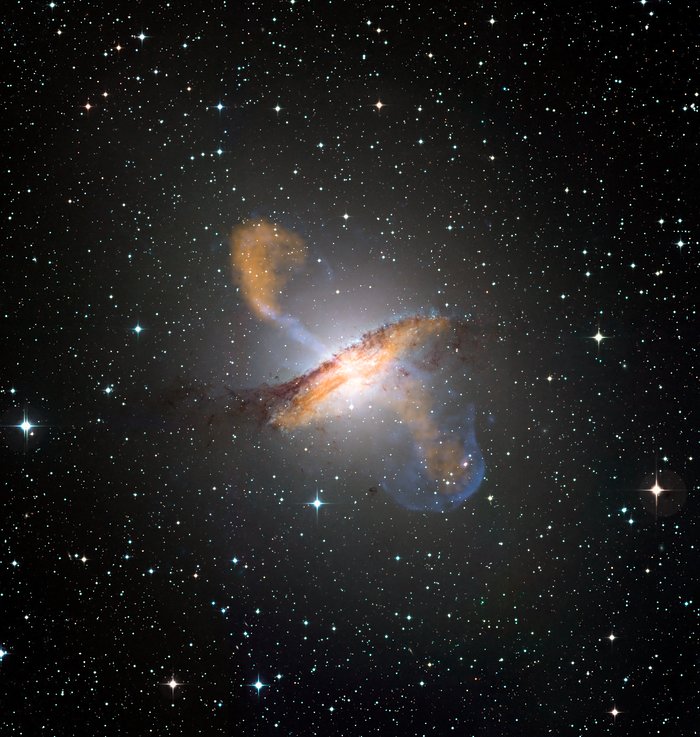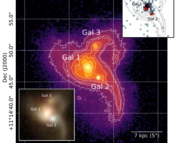Title: The SRG/eROSITA All-Sky Survey: Constraints on AGN Feedback in Galaxy Groups
Authors: Y. E. Bahar, E. Bulbul, V. Ghirardini, J. S. Sanders, X. Zhang, A. Liu, N. Clerc, E. Artis, F. Balzer, V. Biffi, S. Bose, J. Comparat, K. Dolag, C. Garrel, B. Hadzhiyska, C. Hernández-Aguayo, L. Hernquist, M. Kluge, S. Krippendorf, A. Merloni, K. Nandra, R. Pakmor, P. Popesso, M. Ramos-Ceja, R. Seppi, V. Springel, J. Weller, S. Zelmer
First Author’s Institution: Max Planck Institute for Extraterrestrial Physics, Giessenbachstrasse 1, 85748 Garching, Germany
Status: Submitted to arXiv (preprint) and Astronomy & Astrophysics
Providing Feedback
Space is gassy. I’ll acknowledge space gas may not be the most romantic topic for Valentine’s Day, but studying the gas that lies in between stars or around galaxies can provide us with a bounty of information that helps us answer questions about chemical composition, star formation, and feedback. But studying this medium can be incredibly difficult due to faint observational signals and the varied impacts of many different astrophysical processes. Of particular relevance to today’s paper are the processes that heat the gas up (see, here’s your Valentine’s link-we’re getting steamy).

One of the biggest factors is gravity: gas that sits in massive halos can be virialized, or heated to temperatures that directly depend on the mass of their halo. But, crucially, gravity isn’t the only thing that gets gas hot. One of the other major players is Active Galactic Nuclei (AGN) feedback-the process by which accreting matter around a supermassive black hole releases energy back into its host galaxy and beyond. AGN feedback is thought to play a major role in how galaxies evolve over time, but its effects can be hard to study.
Roses in the X-ray
One way to observe the effects of AGN feedback is to look at gas in the X-ray. Gas that has been heated up will emit high-energy X-ray light, and in theory, AGN feedback can be responsible for a lot of that heating. Today’s paper considers the hot gas in galaxy groups, which consist of a few tens of galaxies gravitationally bound together. Galaxy groups are relatively abundant in the universe, and because they are smaller than large structures like galaxy clusters, they make a good target for studying non-gravitational heating effects (read AGN feedback).

The end of January saw the first public data release from the extended ROentgen Survey with an Imaging Telescope Array (eROSITA). eROSITA was launched in 2019 and has been working on an all-sky survey in what we call ‘soft’ X-ray, or the lower energy portion of the X-ray spectrum. It has incredibly high sensitivity and a range of science goals, including mapping out the structure of hot gas in the intergalactic medium, detecting AGN, and studying X-ray sources like supernova remnants and pre-main sequence stars. Today’s paper focuses on identifying galaxy groups in the eROSITA data and extracting many characteristic properties of the gas in between galaxies, what is sometimes called the intragroup medium (IGrM).
Bringing Out the Best
An unprecedented 1,178 galaxy groups were identified in the eROSITA data, but given the faint signals they produced in X-ray wavelengths, the spectral properties of these galaxy groups could not be studied individually. Instead, they were separated into 271 bins, each with ~900 photon counts. The spectra of all the groups were then simultaneously fit to spectrum modeling codes. This process, called co-fitting, allows astronomers to convert individual observations that are too faint to reliably analyze into combined data of many observations with a much higher signal-to-noise. Once the spectra for each bin were generated, the temperatures and entropy of the gas at various radii were calculated.
The resulting temperature-entropy relations at the mid-regions of galaxy groups are shown in Figure 2. The results are nicely consistent with similar work done using the Chandra X-ray Observatory (shown in grey), although, at low temperatures, eROSITA finds higher entropies, most likely due to differing ways of selecting the galaxy group sample.
Simulation and Observation: Making Each Other Better
An important aspect of much modern astrophysics research is comparing observations to large-scale hydrodynamic simulations. This paper extracts the gas conditions in galaxy groups from three different simulations: Magneticum, MillenniumTNG, and OverWhelmingly Large Simulations (often called OWLS-astronomers really love their ‘clever’ acronyms). Each of these simulations handles its AGN feedback in a different way, so by comparing what we see observationally to the computational predictions, we can perhaps determine which feedback model is the most accurate.

Adapted from Figure 16 in Bahar et al. 2024.
Figure 3 showcases these results, comparing temperatures and entropies at three different radii: the cores, mid-regions, and outskirts of groups. The entropies at each radius vary, as does the alignment between simulation and observation. The eROSITA measurements presented in this paper demonstrate a strong ability to constrain feedback treatment in simulations, as there are clear differences between observation and simulation in several cases. Overall, the Magneticum simulation aligns best, although OWLS does a better job in group cores. Due to these mixed results, the authors suggest that the feedback models in all three simulations are not quite adequate when it comes to studies at group scales, although the strong alignment of Magneticum at group outskirts shows promise. MillenniumTNG has the weakest feedback prescriptions of the three, so in general, these results favor strong AGN feedback models. As the authors acknowledge, pushing measurements to lower temperatures could be quite useful for further constraints on AGN feedback models.
Overall, this work provides an exciting glimpse into the powers of new X-ray telescopes when it comes to studying gas conditions. Constraining AGN feedback is a big open problem in astrophysics today, and these results demonstrate the usefulness of X-ray observations in galaxy groups.
Astrobite edited by Sowkhya Shanbhog and Lynnie Saade
Featured image credit: MPE, J. Sanders for the eROSITA consortium




